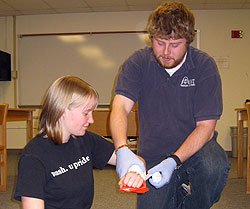Started in 1979 by a handful of students carrying first-aid equipment in their backpacks, the University’s Emergency Support Team (EST) now boasts 53 members, a fully loaded Ford Explorer, several trained emergency medical technicians and a long list of satisfied patients.
EST, a student-run volunteer organization operated under the auspices of the Habif Health & Wellness Center, is celebrating its 30th year on the Danforth Campus.

What began as a humble attempt to assuage concerns over the response time of emergency medical crews from the St. Louis metropolitan region has turned into a 24-hour, seven-days-a-week emergency medical squad capable of assisting in cases from sprained ankles to heart attacks and stroke.
EST began in 1979 as SHOUT (Student Helping OUT) and consisted of 20 students and staff with varying amounts of emergency medical training. They were dispatched via University Police and responded in a golf cart equipped with trauma kits, oxygen tanks and ice packs.
Over the years, the group has evolved into a well-organized and well-trained group of dedicated students. With a home office in Lien House in the South 40, EST offers CPR classes to the community at a reduced cost and uses a Ford Explorer to respond to calls.
Senior Andrew Mullin, a biology major in Arts & Sciences, has enjoyed working with EST during his college career.
“Over the past two years, I’ve been able to teach and train younger, newer medics, which is a lot of fun,” Mullin said. “It’s great to be able to pass along the knowledge I’ve gained as part of this team. I think that’s a reason we’ve been so successful. The older medics love taking time to mentor the younger class, so we are able to maintain high-quality service year after year.”
The responding crew consists of at least two Missouri EMTs and a third member who is at least CPR- and standard-first-aid-certified. In becoming an EMT, students receive 168 hours of classroom instruction and approximately 50 hours of hands-on training in ambulances and the emergency room.
In addition, EST medics receive at least one hour per week of continual training to keep their skills sharp.
Once on a call, EST medics triage patients and decide the best course of action for them. Team members help the patient find the best form of medical care needed — either being treated and released, going to health services on campus for further treatment or going to a hospital via University Police or a Clayton ambulance.
It’s not always an easy task. Teams respond to every medical emergency on campus 24/7 whenever school is in session. When members are on call, they must respond — even if they are studying or sleeping.
The average response time is three to five minutes.
“I think EST is as much a community service organization as it is medical,” Mullin said. “We’ve all learned how to give back to the community, and we’ve become better in dealing with people.”
As EST begins to look toward its next 30 years, there are a few items on the group’s agenda. They have begun to work closely with the University’s emergency planning committee. EST also would like to consider running two crews instead of one, with the second crew having the ability to transport patients to the hospital if necessary.
“EST is a great organization,” said Mullin, who plans to go medical school. “While many of our members are pre-med majors, nearly half are from other schools throughout the campus. It’s a good mix of people working toward a common goal of helping those in need.”
EST welcomes new medics at the beginning of each academic year. For more information on the program or to sign up for CPR classes, visit est.wustl.edu.